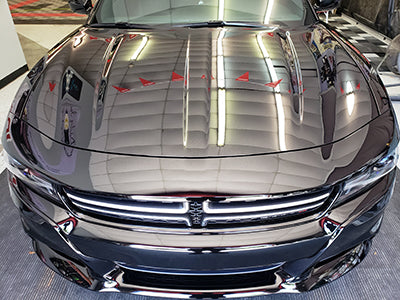Ceramic Coating vs. Typical Wax: Which Offers Much Better Long-Term Protection?
The dispute between ceramic finishings and standard wax for car security has gathered substantial attention amongst automotive enthusiasts and professionals alike. Ceramic finishes boast remarkable longevity and resistance to environmental factors, yet the complexity of their application increases concerns regarding access and usefulness.
Summary of Ceramic Covering
Ceramic layer has gained considerable appeal among auto fanatics and detailers alike because of its sophisticated protective top qualities. This innovative innovation is developed to create a sturdy, hydrophobic guard over a car's paint surface, dramatically boosting its resistance to environmental contaminants such as dust, UV rays, and chemical discolorations. Unlike traditional wax, which gives a short-lived layer of security, ceramic coverings bond at a molecular level with the paint, supplying durable resilience-- frequently prolonging past two years with correct maintenance.
The application process entails meticulous preparation of the automobile's surface, including cleaning and polishing to make sure optimal adhesion. Once used, the covering treatments to develop a durable layer that not only adds deepness and gloss to the paint but additionally simplifies maintenance. With its hydrophobic properties, ceramic covering allows water and dust to move off more easily, lowering the frequency of cleans and minimizing the threat of swirl marks.
Furthermore, ceramic coatings are available in numerous solutions, permitting users to pick items tailored to their certain demands and preferences. Generally, ceramic coating stands for a considerable development in paint defense innovation, delivering remarkable performance contrasted to standard options.
Overview of Standard Wax
Commonly considered a staple in automobile care, wax acts as a prominent choice for those seeking an uncomplicated technique to improve and shield their automobile's paint - ceramic coating. Automotive wax commonly makes up all-natural ingredients, such as carnauba, or synthetic substances, created to produce a safety layer on the surface of the paint. This layer not only enhances the car's gloss and beam but also gives a barrier versus environmental contaminants
The application of wax is generally straightforward, making it easily accessible for both professionals and DIY lovers. Once used, wax calls for a treating period, after which it solidifies to create a safety covering.
However, while wax works for improving the visual allure of a car, it is necessary to keep in mind that the defense it offers might necessitate much more frequent reapplication contrasted to alternate items, such as ceramic finishes. In general, traditional wax remains a popular alternative for those focusing on ease of use and immediate visual renovation.
Resilience and Durability Contrast
While both ceramic finishes and standard wax offer safety benefits for automobile paint, their longevity and longevity vary considerably. Conventional wax, commonly made from all-natural carnauba or synthetic polymers, normally supplies a protective layer that lasts about three to six months. This fairly short life-span necessitates normal reapplication to keep optimal defense.
In comparison, ceramic layers are crafted from sophisticated nanotechnology, developing a covalent bond with the paint surface area. This leads to this a durable, hydrophobic layer that can sustain for two to five years, depending upon the product and ecological problems. The exceptional resilience of ceramic finishings is credited to their chemical structure, which uses improved resistance to scrapes, UV rays, and oxidation.

Defense Versus Ecological Variables
Safeguarding a vehicle's paint from ecological aspects is critical for preserving its look and worth with time. Vehicles are frequently revealed to a selection of components, including UV rays, bird droppings, tree sap, acid rainfall, and roadway grime, all of which can endanger the integrity of the paintwork.
Ceramic finishes provide a durable protection against these environmental assailants. Unlike standard wax, which can degrade swiftly under UV exposure, ceramic layers develop a durable, hydrophobic layer that resists the hazardous impacts of sunshine and toxic wastes. This sophisticated modern technology develops a chemical bond with the vehicle's surface, using superior defense that lasts for many years, also in harsh conditions.
In contrast, ceramic layers keep their safety top qualities much longer, significantly minimizing the threat of paint damage and making certain that the vehicle retains its aesthetic appeal. As an outcome, ceramic layers are progressively recognized as the remarkable option for lasting protection versus environmental variables.
Application and Upkeep Differences
The approaches of application and subsequent upkeep for ceramic coverings and traditional wax vary significantly, influencing the general individual experience and performance of each item. Ceramic finishings require a Discover More more intricate application process, commonly involving surface prep work that includes washing, sanitizing, and polishing the car. When the surface is all set, the ceramic finishing is used in a regulated environment, commonly requiring specialist know-how to ensure appropriate treating and bonding to the paint.

While both products improve automobile appearance, the longer-lasting security used by ceramic finishings might validate their preliminary investment, regardless of the more requiring application procedure. Alternatively, typical wax stays a popular choice for those seeking an easier, albeit temporary, solution.

Conclusion
In verdict, ceramic coatings show considerable benefits over conventional wax in terms of longevity and environmental management. With a life expectancy expanding 2 to 5 years and premium resistance to UV rays, dust, and chemical spots, ceramic finishes use an extra efficient option for long-lasting car maintenance. Although the application process may require expert competence, the resulting expense savings and lowered frequency of reapplication emphasize the worth of ceramic layers for those seeking ideal car defense.
The dispute in between ceramic coverings and standard wax for vehicle defense has garnered substantial focus among automobile enthusiasts and professionals alike. Unlike typical wax, which provides a short-lived layer of defense, ceramic coatings bond at a molecular degree with the paint, supplying durable longevity-- typically extending beyond 2 years with appropriate maintenance.
While both ceramic finishes and conventional wax deal protective benefits for vehicle paint, their resilience and durability differ dramatically. For car enthusiasts seeking lasting security, ceramic layers present an engaging benefit over conventional wax products.
In final thought, ceramic layers YOURURL.com demonstrate substantial advantages over traditional wax in terms of durability and ecological security.